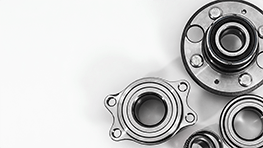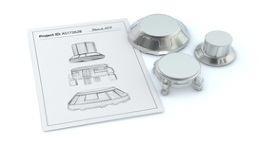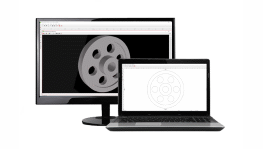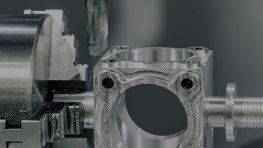Threading
eMachineShop utilizes threading tooling to complement our full range of CNC machining equipment.
- 50+ Materials.
- FREE Shipping in the USA.
- 100% Quality Guaranteed.

Custom CNC Threading and Tapping Services
eMachineShop specializes in providing top-notch CNC threading services. Our expertise in various threading types, coupled with our state-of-the-art equipment, ensures the highest quality and precision in every project. Contact us for your custom threading needs.
Threading is a complex but essential part of CNC machining that requires precise measurements, practical design placement and considerations, and appropriate material selection. Understanding the different types and sizes of threads, how they are measured, and the importance of selecting the right material ensures the production of high-quality, functional components for a wide range of applications.

What is Threading?

Threads, or screw threads, are helical ridges around a cylinder used to convert rotary motion into linear motion and to securely fasten parts together when rotary motion is restricted. In manufacturing, threading is the process of making screw threads, both right and left-handed, male and female. Common standardized thread types include ISO Metric, Unified Thread Standard and National Pipe Thread.
Threading Types and Sizes
Threads can be categorized into two main types: metric and imperial.
- Metric Threads: These are measured in millimeters and are commonly used globally. They follow the International System of Units (SI) standards.
- Imperial Threads: Used primarily in the United States, these threads are measured in inches and follow the Unified Thread Standard (UTS).
Within these categories, threads can vary in profile, pitch, and diameter, leading to different classifications such as:
- ISO Metric Thread: The most widely used thread form worldwide, characterized by a 60-degree angle.
- Unified Thread Standard (UTS): Includes Unified Coarse (UNC), Unified Fine (UNF), and Unified Extra Fine (UNEF) threads.
- British Standard Whitworth (BSW): Features a 55-degree thread angle, commonly used in older British machinery.

Understanding Coarse & Fine Threads
Fine Threads: Fine threads have a smaller pitch (the distance between threads is closer). This means they have more threads per unit length than coarse threads.
Fine Threads are ideal for applications where strength is crucial, and precision adjustments are needed. Common in applications with limited space due to their higher strength per diameter. They are also preferred in applications subject to vibration, such as in aerospace or automotive industries.
Coarse Threads: Coarse threads have a larger pitch with fewer threads per unit length. This is the most common thread type found in general hardware.
Coarse threads are best suited for general construction, wood applications, or where fast assembly and disassembly are required. They are also preferable in environments where the threads may become dirty or in materials prone to splitting, like plastic or cast iron.
When To Use Coarse & Fine Threading
The choice between fine and coarse threads depends largely on the specific requirements of the application, including the material being used, the environment in which the fastener will operate, and the need for precision in adjustment or resistance to vibration. Understanding these differences is key to selecting the right type of thread for any given task in mechanical design and assembly.
Below is a chart which outlines when it is typically best to use each threading style in regards to a specific feature:
| Feature | Fine Threads | Coarse Threads | When to Use |
|---|---|---|---|
| Pitch | Smaller pitch, more threads per unit length | Larger pitch, fewer threads per unit length | – |
| Strength | Higher tensile strength due to larger thread cross-section | Slightly lower tensile strength | Use fine threads in applications where strength and precision are crucial |
| Precision | Allows for finer adjustments | Coarser adjustments | Use fine threads for precise load or movement adjustments |
| Resistance to Loosening | Less prone to loosening under vibration due to smaller helix angle | More prone to loosening under vibration | Use fine threads in applications subject to vibration (e.g., aerospace, automotive) |
| Assembly | More careful handling needed, higher risk of cross-threading | Easier and faster to assemble, less prone to cross-threading | Use coarse threads where quick or frequent assembly/disassembly is required |
| Susceptibility to Contaminants | More easily clogged with dirt or debris | Less likely to clog with contaminants | Use coarse threads in dirty environments or outdoor applications |
| Material Suitability | – | Better suited for brittle materials as they exert less stress | Use coarse threads in brittle materials (e.g., plastic, cast iron) |
Measuring Threads
The measurement of threads is critical for ensuring compatibility and functionality. Key parameters include:
- Diameter: The overall width of the thread. For bolts, it’s the shank diameter, and for nuts, it’s the internal diameter.
- Pitch: The distance between two adjacent thread crests in metric threads, or the number of threads per inch (TPI) in imperial threads.
- Thread Angle: The angle between the thread flanks.
Tools like calipers, thread gauges, and micrometers are used for accurate measurement.

The Role of Tapping
Tapping is a specific type of threading, primarily used for creating internal threads within pre-drilled holes. This process involves using a tap, a cutting tool designed to cut threads inside a drilled hole. Tapping can be performed manually or with a machine.
Correlation Between Tapping and Threading
Tapping and threading are interconnected in the following ways:
- Complementarity: Tapping is essentially threading for internal surfaces. While threading can be external or internal, tapping is exclusively for creating internal threads.
- Interdependence: The effectiveness of a tapped hole (internal thread) is directly dependent on the compatibility with its corresponding external thread (e.g., a bolt).
- Precision and Accuracy: Both processes require high precision. The dimensions and tolerances of both tapped holes and external threads must align to ensure proper fit and function.
Common Tapping Sizes and Corresponding Hole Sizes
| Tapping Size (Thread) | Tap Drill Size (Hole Size) |
|---|---|
| M2 x 0.4 | 1.6 mm |
| M2.5 x 0.45 | 2.05 mm |
| M3 x 0.5 | 2.5 mm |
| M3.5 x 0.6 | 2.9 mm |
| M4 x 0.7 | 3.3 mm |
| M5 x 0.8 | 4.2 mm |
| M6 x 1.0 | 5.0 mm |
| M8 x 1.25 | 6.8 mm |
| M10 x 1.5 | 8.5 mm |
| M12 x 1.75 | 10.2 mm |
| 1/4-20 UNC | #7 (3.4 mm) |
| 5/16-18 UNC | F (6.9 mm) |
| 3/8-16 UNC | 5/16″ (7.9 mm) |
| 1/2-13 UNC | 27/64″ (10.7 mm) |
| 5/8-11 UNC | 17/32″ (13.5 mm) |
Metric Threads (M): The numbers following ‘M’ indicate the nominal diameter in millimeters, and the number after the ‘x’ is the pitch (distance between threads).
UNC Threads: This is a standard for Unified Coarse threads. The numbers indicate the diameter in inches and the number of threads per inch, respectively.
Hole Sizes: Listed in millimeters for metric threads and in inches or drill size for UNC threads.
Placement Considerations in 2D Custom Parts
2D parts, typically flat or sheet materials, require precise threading for effective fastening. Key considerations include:
- Positioning: Threads must align with mating parts. Accurate CAD drawings and CNC programming ensure correct placement.
- Spacing: Adequate space between threaded holes is crucial to maintain structural integrity and prevent material warping or breakage.
- Orientation: Threads should be oriented to optimize load distribution, particularly in high-stress applications.
- Tapping Depth and Size: Ensuring correct tapping depth and size is crucial for the threads to hold effectively, particularly in thinner materials used in 2D designs
Integrating Bending with Threading and Tapping
In 2D part design, a comprehensive understanding of bending, and threading and tapping is imperative. It not only influences the functionality of the part but also its manufacturability and durability. Designers must consider these aspects in unison to create efficient, reliable, and cost-effective parts.
Combining CNC bending features with threading and tapping processes in 2D designs presents unique challenges:
- Alignment Post-Bending: If threading or tapping is required near a bend, the deformation of the material during bending can affect the alignment and integrity of the threads.
- Material Thickness: Bending can thin out material at the bend site, which may affect the depth and strength of tapped threads.
- Tolerance Stack-Up: In designs with multiple bends and threaded features, tolerances can stack up, leading to misalignments and fit issues.
Design for Manufacturability (DFM)
Understanding these elements is essential for DFM:
- Simplifying Designs: Balancing the complexity of bends and threaded features can simplify manufacturing processes, reducing costs and time.
- Tool Access: Consideration of tool access for threading and tapping post-bending is vital, especially in confined spaces.
- Prototyping: Prototyping can be invaluable in testing the feasibility of designs, particularly where complex bends and threads intersect.
Placement Considerations in 3D Custom Parts
3D parts, with their complex geometries, present unique challenges for threading and tapping:
- Accessibility: Placement should consider the accessibility of tapping tools, especially in confined or intricate areas.
- Depth and Angle: Thread depth and angle must be consistent with the part’s design and intended use, factoring in the limitations of 3D geometries.
- Stress Concentration: Avoid placing threads in areas of high stress concentration to prevent failure.
Material Selection for Threading
The choice of material is vital in threading, affecting the strength, durability, and application of the threaded component. Factors to consider include:
- Strength and Durability: Materials like steel, stainless steel, and titanium offer high strength and are suitable for heavy-duty applications.
- Corrosion Resistance: Stainless steel and aluminum alloys are preferred in corrosive environments.
- Machinability: Some materials are easier to machine than others, impacting the overall cost and time of production.

Common Applications of Threading and Tapping Across Industries
Threading and tapping are fundamental processes in manufacturing, utilized across various industries to create components that are integral to their operations. Below are just some of the many of the diverse sectors that rely on these services and provide examples of their applications.
Aerospace Industry
Key Usage: Precision and reliability are paramount in the aerospace sector. Threading and tapping are used extensively for both structural components and engine parts.
Examples:
- Engine Components: Threads are critical in jet engines for securing blades, casing, and assembly parts.
- Aircraft Fasteners: Tapped holes are essential for fasteners that hold together fuselage panels, wings, and other structural elements.
Automotive Industry
Key Usage: Threading and tapping are crucial in the assembly and maintenance of vehicles, from personal cars to heavy-duty trucks.
Examples:
- Engine Bolts: Tapped holes in engine blocks for bolts that secure the head, transmission, and other components.
- Suspension Systems: Threaded rods and bolts are used in suspension systems, requiring precise tapping for adjustments and alignment.
Construction Industry
Key Usage: Durable and robust threading and tapping are needed for the construction industry’s heavy materials and structural demands.
Examples:
- Building Frameworks: Threaded rods are used to anchor structural elements in buildings.
- Plumbing and Electrical Systems: Threading is essential for pipe fittings and electrical conduit installations.
Medical Industry
Key Usage: In the medical field, threading and tapping are used for precision instruments and implants, where accuracy and biocompatibility are essential.
Examples:
- Surgical Instruments: Threaded components are common in adjustable or multi-part surgical tools.
- Orthopedic Implants: Tapped holes in implants like screws and plates for bone reconstruction.
Electronics Industry
Key Usage: Threading and tapping are used in the electronics industry for assembling small, precision components, often in high-volume production.
Examples:
- Consumer Electronics: Threaded fasteners are used in the assembly of smartphones, laptops, and other devices.
- Circuit Board Standoffs: Tapped standoffs are used to mount circuit boards within electronic devices.
Marine Industry
Key Usage: Threading and tapping are vital in the marine industry, ensuring structural integrity and functionality in harsh environments.
Examples:
- Boat Building: Threaded fasteners are extensively used in the construction of boats and ships, securing hulls, decks, and various components together.
- Piping Systems: Threaded connections are crucial in marine piping for fluid control in fuel, water, and hydraulic systems aboard vessels.




